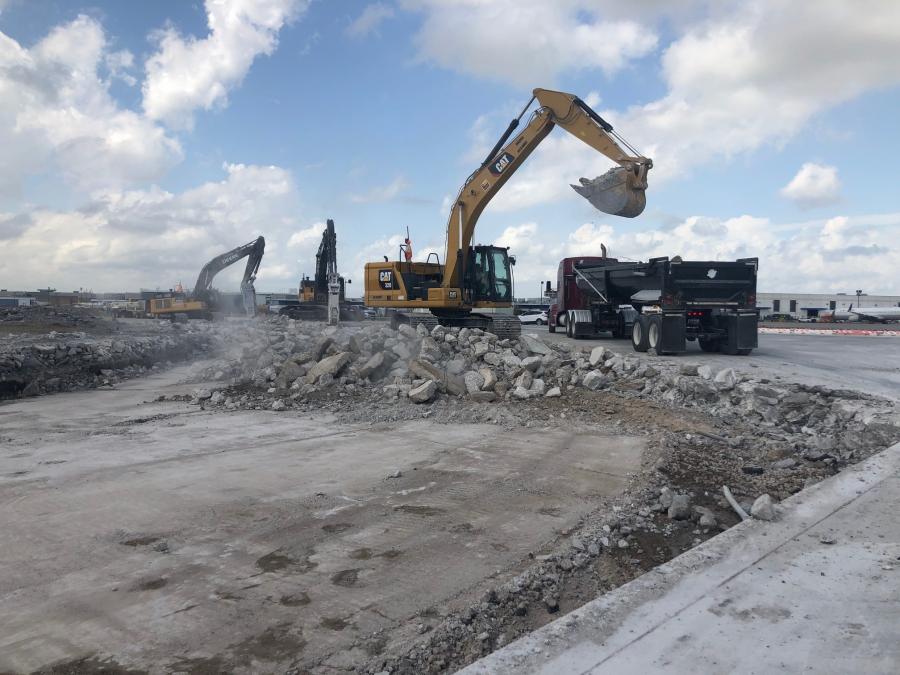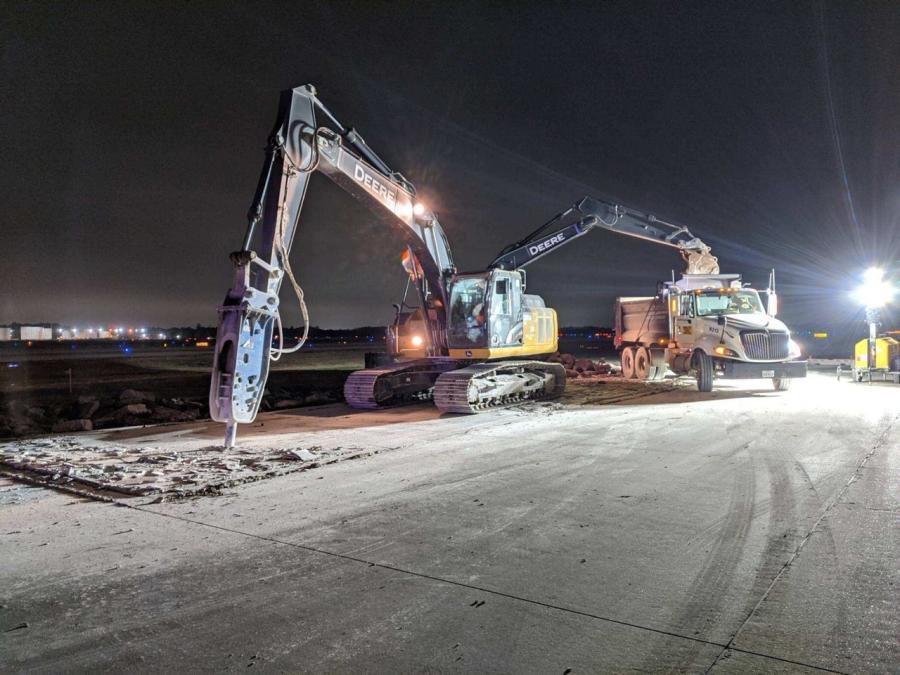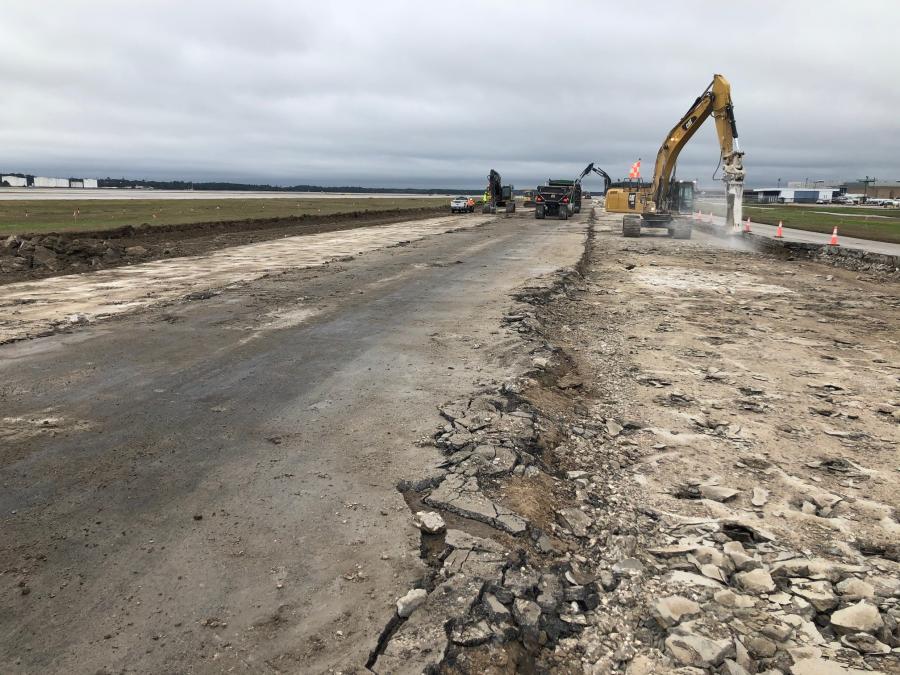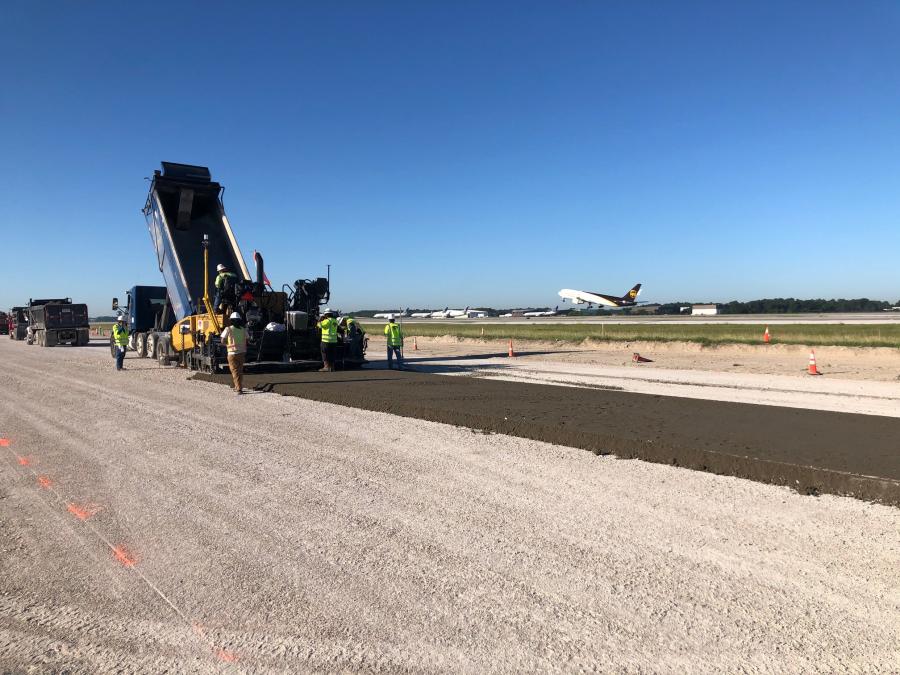Construction crews from Flatiron are making steady progress on the $58.9 million rehabilitation of Taxiway WB at George Bush Intercontinental Airport (IAH).
Seven months into the Houston Airports System (HAS) $58.9 million rehabilitation of Taxiway WB at George Bush Intercontinental Airport (IAH), construction crews from Flatiron are making steady progress on the project that began in early February and has a projected delivery date of early 2022.
The goal of the project is to ensure the efficiency and value of the IAH taxiway, extending its useful lifespan by a minimum of 20 years and greatly increasing safety for planes taking off and landing.
The rehabilitation is part of the HAS's move towards its 5-star future. This was the fifth year in a row that HAS received a 4-star rating and the third straight year IAH received the same distinction from Skytrax, a leading global air transport rating organization.
"Beyond the present crisis, these 4-star ratings are indicative of the consistency and sustained excellence that each Houston Airports' employee is committed to," said HAS Director Mario Diaz."Despite this crisis [COVID 19], we will use this time to continue to make improvements that will help us reach our vision of establishing Houston Airports as a 5-star global air service gateway where the magic of flight is celebrated."
Project Scope
The scale and scope of the Taxiway WB initiative is considerable — a full-depth reconstruction, including associated pavements to facilitate a fully functioning taxiway system; construction of storm water underdrains beneath the taxiway; and furnishing and installing new LED centerline lights.
This is backed up by the amounts of materials which will be brought in for the phased construction: 111,500 sq. yds. of total concrete paving; 87,500 sq. ft. of phased airfield paving markings; 118,000 sq. yds. of bituminous concrete pavement section demolition; and 15,450 tons of bituminous surface course.
Robert Barker, chief infrastructure officer at HAS, said, "We fully recognize that significant infrastructure needs have to be properly addressed in order for us to remain competitive in the global marketplace. We are actively working to ensure that our facilities not only meet but exceed demands for increased capacity and optimum efficiency."
The key benefits of the project are: upgraded aircraft guidance lighting and signage; new markings which will improve movement of pilots – better visibility to the airfield; vast improvements to the intersections and paving; reduced maintenance costs, which translates into minimal impacts to airport operations; and allowing for the movement of larger aircraft to the north end due to changing some of the radiuses and associated happenings.
"Right now the team is focused on demolition – we must demolish up to three separate layers of pavement, all the way down through the subgrade," said Chad McGhee, HAS construction manager. "We are demolishing roughly 45 inches of total thickness and we will build it back to the HAS current standards. The next steps will be to stabilize the subgrade, then return with embankment fill and build it back up to the paving."
The project was designed by RS&H Inc.
"IAH originally undertook a rehabilitation project several years' back for Taxiways WA and WB, along with several connector taxiways and multiple connector taxilanes to one of the western complex' runways [west side of IAH]," said McGhee.
Unforeseen construction issues kept these taxiways closed for several years.
McGhee is working with HAS Construction Manager Johnathan Limb, Resident Engineer Robert Vinson and Airfield Operations Construction Coordinator Jeff Cruser.
"Close coordination is always important," noted McGhee, "as we are also about to undertake the Sanitary Sewer Rehabilitation Project, which will certainly overlap with this taxiway rehabilitation."
Taking on both taxiway projects has ensured more efficient construction.
"This allowed us to start work on WB more quickly," said Michael Zanella, Flatiron's Houston area manager. "My experience with airport work started back in the 1980s as the site superintendent for the initial O'Hare International Airport expansion and since then I've worked on Jacksonville International Airport, McChord Air Force Base and a small airport outside of Harrisburg, Pennsylvania. Working with several different airport authorities has allowed me to bring those experiences here and put in some of the best construction practices terms of specifications, what the client is looking for, and helping field operations from a high level to ensure our team is successful.
"We have numerous safety protocols in place, such as maintaining proper distances between the taxiway and the runway," he added. "It's extremely important that when planes are coming in and out of our work zone or to other operational taxiways, that all of our flags and lighting are identifiable, and airport operations know exactly where we are. We have the right personnel in place, including the subcontractors who play a very big and important role in our work. Through trials and tribulations, you better understand sequencing, operations and maintaining schedules, which are extremely important out here. We've developed stronger work plans because of that earlier work."
Relations with HAS and airport operations staff have been excellent.
"Communications is key and working with their assistant director has ensured we have been able to meet all the terms of the contract," said Zanella. "There will always be site differences and things that are not in the plans that we have to work through. This partnering allows us to get through issues we run into."
Elizabeth McNew, Flatiron's traffic control foreman, stressed how heavy rains have been a challenge.
"We work whenever we can," she said. "It rains pretty hard and we can be out for a good four or five days. We work 24/7 with day and night shifts. If it rains during the day, we just pick up wherever we can. I learned how to handle the gate and airport regulations and rules, and the concerns of airport operations. If we're low on supplies, we'll bring them in rapidly. Safety is a constant concern, and Alex Castellanos, our safety manager, is on top of things at all times. We have flaggers to clear the area when planes pass by. Some of the hangers have scheduled times for when planes come out, and we have to stop all traffic at those times."
Soil and utility issues are being dealt with as they arise.
"Storm water is an issue we're always dealing with," said Tim Gee, Flatiron's project manager.
Flatiron has dirt work/excavation, pipe installation and paving crews working simultaneously.
"If there are issues, they usually work together on them," said McNew. "We have plenty of room. The yard is pretty big and we have room the for concrete batch plant, storing of materials and offices. It doesn't take too long to reach the construction site by the service road."
The demolition and reconstruction of WB is being done in phases, having started at the north end and proceeding to the south end. Currently three phases of WB are being worked on – 5, 5B and 5C. The plan of attack for the demolition, for which 20 percent has been done, depends on the type of pavement being encountered.
"We're pre-planning for future phases," said Gee. "We've got some very different pavement sections – up to 39-inches deep and you can't use a guillotine piece of equipment to break it up and load it out. We're using hydraulic hammers to break it up. There are several different layers of pavement that were poured – you have a top eight inch layer that is unreinforced and then 24 inches of reinforced concrete below that, followed by another unreinforced section. It's hard on the equipment. We have two Cat 336 excavators with 15,000-pound hammers running double shifts."
A phase is 1,600 ft. long and takes about 1.5 weeks to demolish.
Trimble Total Station robots are being used to meet specifications for the new taxiway.
"The tolerances are tight in regards to specifications and the robots' level of accuracy is down to the 32nd of an inch rather than a one-half inch with GPS," said Gee. "The only times we're going to use GPS is when we have machine controls on a motor grader for grade and subgrade on the shoulders."
The excavated material is removed a few days later after being broken up to let crews push ahead. This material is picked up by Cat 336s and placed in Cat 966 loaders.
"Once we start loading out, we have two options," said Gee. "We can bring it to a subcontractor – eight miles away, to be crushed and turned into P2 219, our base material and P304, a cement stabilized base. We just recently started bring the material to our yard and stockpiling it. We've brought in a machine to crush it on-site so we can make our P2 219 and P304."
The Erie wet batch plant at the yard is expected to produce 78,000 cu. yds. of concrete.
"The paving crews usually pour at night and on a good day, close to 1,000 tons can be poured," said McNew.
Gee pointed out that light traffic is generally permitted on the new concrete after three days, and complete curing takes about seven days.
The new taxiway is based on a 5 in. P2 219 base, followed by an 8 in. cement treated base, 1 in. thick asphalt bond breaker and an 18 in. thick concrete top. Before the paving can begin, the subgrade has to be stabilized.
"We use a cement slurry," said Gee. "We'll dump some cement on the subgrade, mix it up and let it cure."
Paving operations are proceeding smoothly and lessons learned from WA are being applied.
"Any time we demolish a section of taxiway," said Gee, "we have to take extreme caution so we don't cause spalling or damage the pavement that is proposed to be left in place. With each new phase, we look at what happened in the last one – and what we can learn from the experience. We'll step two feet away from an edge that remained in place, put in a relief cut – full depth to the bottom and then work our way back to the relief cut so were not putting any pressure on the pavement that stays. The key is to not put too much pressure on it."
For the storm water underdrains, the pipe crews are installing perforated PVC pipe wrapped with ¾-in. rock and filter fabric around it.
"They are installed prior to the concrete pours and placed on the shoulders of the taxiway," said Gee.
The locations for the LED centerline lights, edge lights, and manholes for the conduits and conductors to tie them into have been mapped out. EAS is installing the lights and is handling all of the electrical work.
Gee is assisted by Field Superintendent Shane Flowers and Field Engineers Bharath Reddy Romdla and Jereon Dijkema.
"Whenever a problem arises, they all work together on it," said McNew. "We have meetings every Monday and Friday. On Mondays they go over what is going to take place in the next two weeks and on Fridays, they review weekly progress and if there are changes, come up with alternative plans. Everyone is working hard to meet the schedule. We have a lot of employees that have been here since WA and you can see the teamwork that has developed. They know the drill and look after each other – they want to get the job done. Everyone is getting enough hours and I'm happy for my employees,. We haven't been rained out lately. WB is going smoothly."
Peak days have nearly 60 Flatiron and subcontractor personnel on-site for each shift, with the main subcontractors being ADF Trucking, Agg Tech Aviles, Environ-mental Allies, Evans &Sons, GMJ, HPSI, Proair, Romar Trucking and Stripes & Stops.
The amounts of excavated materials – concrete, rebar and asphalt – will only be tabulated towards the end of the project.
Flatiron also is using: excavators: a Cat 308 with a hammer and a John Deere 135G; a Cat D6N dozer; a John Deere 644K loader; a Cat C556 roller; a Cat hydraulic box blade; Cat boomlifts, forklifts, buggies and light plants; sweepers; air compressors; backhoes; and a water truck.
"We have a mechanic who works with our concrete paving group," said Gee. "Any time that we're doing high production paving, he'll be there to deal with a hose break or any other issue. He also helps with sizing the pan to get the width we need and pre-check the machine before we start the pour to make sure it is in good and operating condition. The key to maintaining the equipment is daily inspections. When you see an issue, you have to bring it up with our equipment department or vendor that we rented it from. You have to locate high wear and tear items like cutting edges and teeth on buckets. When they get low, you have to replace them before it's too late."
In the Houston and southeast Texas area, Flatiron purchases and rents equipment from Mustang CAT, United Rentals and Doggett Equipment Services Ltd. for John Deere machinery.
"If we have a downed piece of equipment, they get out here as soon as they can to either fix it or replace it," said Gee."Fostering good relationships with the dealerships is touching base with them periodically to see how everything is going and see what we can do to help them and vice-versa, they call us to see what they could do to help us."
Airport Background
IAH is among the busiest airports in the country. In 2019, it served almost 45.3 million passengers, a 3.3 percent increase from 2018. The taxiway upgrades are part of the plan to improve customer service as the number of passengers continues to increase.
"Houston Airports is actively working to ensure that our facilities not only meet but exceed demands for increased capacity and optimum efficiency," said Barker.
"The work requires considerable coordination because of its impact to cargo carriers, tenants and others," said McGhee. "The [construction] has been carefully phased, with some phases of work being performed exclusively at night and other phases during the day since the entire taxiway cannot be shut down during construction. As always, we'll seek to minimize operational impacts during construction."
The WB reconstruction was added to the project as substantial completion on WA ($52,319,889.69) was approaching, which began on Oct. 19, 2018, was substantially completed on Oct. 10, 2019, and reopened the same month.
McGhee stressed that improving airfield conditions are critical and go together with improving the customer experience.
"Houston Airports has more than $1 billion of airside civil work -- either in planning, design or under construction," he said, "and that just strongly illustrates its ongoing commitment to safety, to service, and to state-of-the-art infrastructure." CEG
Today's top stories




























